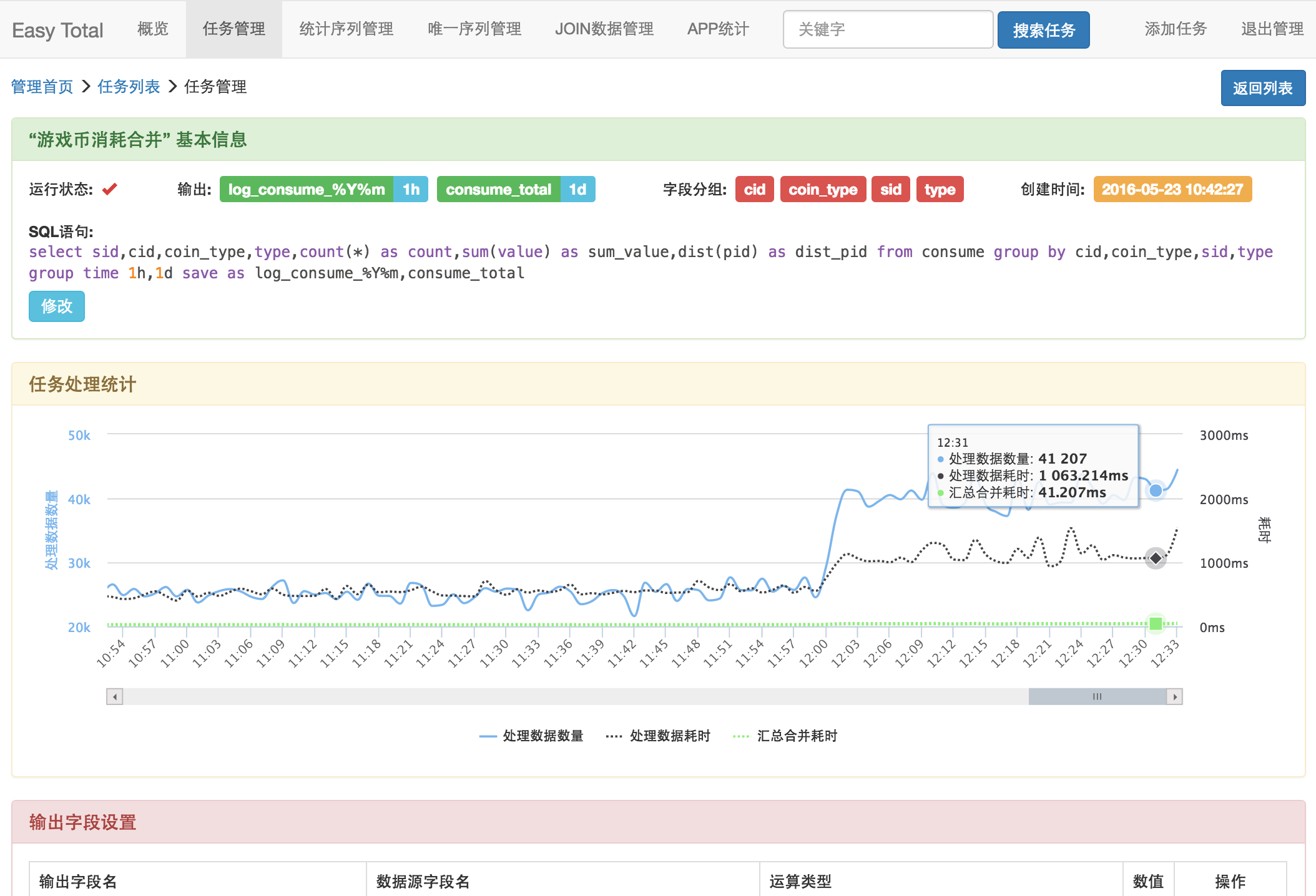这是一个通过监听统计的SQL语句的方式,对汇入的数据进行实时处理后不间断的将统计结果导出的服务器解决方案,它解决了日志数据量非常巨大的情况下,数据库无法承载巨大的插入和查询请求的问题,并且可以满足业务统计的需求。它具有很高的性能,实测单机每分钟能处理600万+的日志量,核心价值之一在于把单位时间内的数据合并成1条数据输出以实现大幅缩减统计数据量的目的。
支持常用的运算统计功能,比如 count, sum, max, min, avg, first, last, dist,支持 group by,后续将会增加 join 的功能。
例: select count(*), sum(value) as sum_value, first(time) as begin_time, last(time) as last_time from, dist(ip) from test where status = 1 group by type group time 1h, 1d save as total_test_limit_hour, total_test_limit_day
它表示将数据按每小时、每天汇总,并且按 type 字段分组,运算后将每小时的数据存入到 total_test_limit_hour 中,每天的数据存到 total_test_limit_day 中,字段说明如下:
| 字段 | 说明 |
|---|---|
| count | 条数 |
| sum_value | 相加的value值 |
| begin_time | 第一条的时间值 |
| last_time | 最后一条的时间值 |
| ip | 唯一IP数 |
特点:
- 实时处理,定时汇出统计结果;
- 将巨大的日志量汇总成1条或多条输出,可以成万倍的缩小数据体量,后续可在这样的汇总结果中进行二次统计;
- 特别适用于对大量log的汇入统计,免去了先入库再统计这种传统方式对系统造成的负担;
- 占用内存很小;
- 分布式水平扩展,支持随时增删统计服务器;
程序需要 php 环境并安装 swoole、redis、msgpack 等php扩展,推荐 php7+, swoole 1.8.0+。需要安装并配置 redis 或 ssdb 服务器用于存储运算中的数据。
数据的汇入汇出使用 Fluentd 处理,推荐使用 Fluentd 来收集和分发日志,相比 flume 它没有 java 的那一套复杂的东西。
ln -s ./easy-total /usr/local/bin/easy-total
cp ./server.ini /etc/easy-total.conf
请查看 server.ini 中有详细说明,其中 [server] 为服务器信息设置,运算中的临时数据将会存到 [redis] 配置的服务里,建议不要和其它服务混用
直接运行 easy-total 即可,参数
| 参数 | 说明 |
|---|---|
| -c path | 配置文件路径,默认 /etc/easy-total.conf |
| -l path | 日志路径 |
| -d | 守护进程化方式启动 |
| --debug | 开启debug |
页面管理工具端口同API端口,默认 8000,例如 http://127.0.0.1:8000/admin/
API为HTTP协议,端口默认 8000,可在配置[manager]部分修改,例如 http://127.0.0.1:8000/api/task/list
api/task/add添加一个SQL任务api/taak/remove移除一个SQL任务api/task/list查看所有任务SQL列表api/task/pause暂停一个任务(暂未实现)api/task/start启用一个任务(暂未实现)api/server/stats服务状态api/server/reload重新加载服务器子进程(注意:如果修改配置这样重启是没有用的,需要完全退出进程后重启服务)
curl -d 'sql=select *,count(id) as count,dist(id) from test group by type' 127.0.0.1:8000/api/task/add
将会返回类似json,其中 queryKey 表示当前注册的新的sql的key
{
"status": "ok",
"key": "31fa9231535a10ab",
"saveAs": "test_consume",
"sql": "select cid,count(*) as total,sum(value) as sum_value,last(time) as last_time from consume group by cid group time 1h save as test_consume"
}其中 sql 是经过系统格式化后的新的SQL语句,未知的参数将会被过滤掉。
curl -d 'sql=select *,count(id) as count,dist(id) from test group by type' 127.0.0.1:8000/api/task/remove
curl 127.0.0.1:8000/api/task/list
语法关键字(按顺序):
- select
- from
- for
- join on 暂不支持但在计划开发功能之列
- where
- group by
- group time
- save as
例:
select field1,field2 as test from test where type=1 and (statu = 2 or statu = 3) and tid in (1,3,5,7,9) group by type group time 3m save as newtable
其中,select 和 from 为必须出现的关键字,其它为可选关键字,group time 不设置则默认为 1m,save as 不设置则默认和 from 相同
select 部分支持 *|count|sum|max|min|avg|first|last|dist|exclude|listcount|list 等方法,除*外其它都支持as
说明
- count - 不管是 count(field1) 还是 count(field2) 都是一样的值,差别是 count(field1) 相当于 count(*) as field1, count(field1) 相当于 count(*) as field2
- dist - dist(id) 会直接得到id序列的唯一count数
- exclude - 排除某个字段,比如 select *,exclued(f1),exclude(f2) 将会排除f1和f2两个字段,其它都保留
- list, listcount - 将数据全部放在列表里、对应count数,暂未实现
from 只支持单表
for 是用来指定项目匹配的,不设置则默认全部。比如 select *,count(count) from test for app1,app2 时,当log的tag是 app1.test 则会解析,而如果是 app3.test 则会忽略。
这边需要强调的是, app1.test 和 app2.test 都符合条件,但是他们的运算数据都是独立的,不会相互干扰的,默认情况下, app1.test 将会输出到 merged.app1.test,app2.test 将会输出到 merged.app2.test。
和mysql语句相同,支持复合条件,比如 where a=1 and (b=2 or b=3) and (d=1 or (e=2 and e = 3))
支持 in 条件,比如:where id = 3 and type in (2,4,6)
支持 not in 条件,比如:where id = 3 and type not in (2,4,6)
支持个别方法,比如:
a % 10 = 1a >> 10 = 1a << 10 = 1a / b = 1a - b = 1a * b = 1a + b = 1from_unixtime(a, '%Y-%m-%D %H:%i:%s') = 2016-10-10 10:10:01unix_timestamp(a) >= 1234567890
匹配符支持:
><!=或<>>=<=
根据字段分组,例如 group by a,b 表示按a和b两个字段同时进行分组
这个是一个 特有 的关键词,不设置则默认是 group time 1M(1分钟)。它的用途是按时间戳将数据分组,在1组里数据将会和另外一组的数据隔离,也就意味着你去算dist,sum等时,是分开来的,输出导出时也是分开的。
支持1条SQL多个分组序列,例如 grouu time 1d,1h,10M 表示数据将分别按1天,1小时,10分钟分成3组分别输出3份序列,但是需要注意的是,每个序列都是独立的,分组序列越多也就意味这系统需要暂存的数据就会越大。
可选参数:
| 参数 | 简写 | 示例 | 说明 |
|---|---|---|---|
| year | y | 1y | 按年分组 |
| month | m | 1month | 按月分组(注意是小写的m) |
| week | w | 1w | 按周分组 |
| day | d | 1day | 按天分组 |
| hour | h | 2h | 按小时分组 |
| minutes | M 或 i | 1M | 按分钟分组(注意是大写的M) |
| seconds | s | 30s | 按秒分组 |
| none | none | 强制不按时间分组,此时建议按 group by 主键字段分组可得到去重后的数据,请不要使用在不断增长且需要统计的序列上,否则缓存的序列将会同步增长且无法被系统自动清理 |
使用例子:
假设sql语句是 select *, count(*), dist(title) as dist_title, first(id) as first_id from test,下面有几条数据
| id | title | time (time应该是时间戳,但为便于识别所以写成了以下日期的格式) |
|---|---|---|
| 1 | a | 2016-05-01 20:20:10 |
| 2 | a | 2016-05-01 20:20:20 |
| 3 | a | 2016-05-01 20:21:10 |
| 4 | a | 2016-05-01 20:21:20 |
| 5 | b | 2016-05-01 20:21:30 |
那么如果 group time 1M (默认) 的话则会产生2条数据分别是
| _id | _group | id | title | time | count | dist_title | first_id |
|---|---|---|---|---|---|---|---|
| 1i_1234567 | 1234567 | 2 | b | 2016-05-01 20:20:20 | 2 | 1 | 1 |
| 1i_1234568 | 1234568 | 5 | e | 2016-05-01 20:21:30 | 3 | 2 | 3 |
那么如果 group time 1d (1天) 即 select *, count(*), dist(title) as dist_title, first(id) as first_id from test group time 1d save as test_per_1d ,则会产生1条数据:
| _id | _group | id | title | time | count | dist_title | first_id |
|---|---|---|---|---|---|---|---|
| 1d_1234567 | 1234567 | 5 | e | 2016-05-01 20:21:30 | 5 | 2 | 1 |
(ps: 以上 _id,_group 是系统生成的,1d_1234567 只是一个列子,并不表示一定是它)
鉴于实际的统计需要,可以对同一个数据重复添加相应的sql监听需求以满足业务需求。
另外需要注意的是,系统是实时统计进行迭代更新的,所以如果按1day分组的话,系统会在每分钟(默认设置,可在配置中修改)导出更新一次数据,所以需要确保 _id 字段为主键或唯一索引。
将统计出的数据保存到一个新的关键字序列,默认不写则和来源一样。例如: select count(*) from test save as newtable 。
支持时间通配符,例如 save as test_%Y_%m 表示数据将按 test_2016_02, test_2016_03 这样分别导出存储,方便分表分库。
通配符参数前缀都是 % 开始,常用时间参数如下(注意大小写):
- %Y - 年
- %m - 月
- %d - 日
- %H - 时
- %i - 分
- %s - 秒
- %W - 周
更多参数请见 http://php.net/manual/zh/function.date.php
多时间序列分别导出,例如: select * from test group time 1d,1h save as test_day_%Y%m, test_hour_%Y%m%d 有2个时间序列统计则会分别导出到 test_day_201604 和 test_hour_20160406 里。
前缀设置:在配置里的 [output] 中可以设置 tag_prefix 输出前缀,例如 tag_prefix = merged.,如果请求的tag是
log.app1.test 则会输出到 merged.app1.test
完全兼容 Fluentd 协议,并同时支持 json、msgpack方式,see http://docs.fluentd.org/articles/in_forward
每个数据库包的大小请不要超过6MB
[tag, time, record, option]
例如:
["myapp.test",1234567890,{"id":1,"hello":"world"},{"chunk":"abcdef"}]其中 abcdef 为随机字符串,服务器收到消息并处理则会返回如下ACK确认内容:
{"ack":"abcdef"}如果超过180秒没有返回则可视为处理超时,重新提交。
[tag, [[time,record], [time,record], ...], option]
例如:
["myapp.test",[1234567890,{"id":1,"hello":"world"},1234567891,{"id":2,"hello":"world2"}],{"chunk":"abc"}]处理成功后返回ack确认同单条模式。
处理后输出格式同TCP协议,可以用 Fluentd 接受数据。
另外,不管是单条还是多条模式, option参数都是可选的,不传则服务器不会有任何返回,这个可以在测试期间使用,但是因为没有ACK确认,所以你无法知道服务器到底是否处理成功,所以生产环境务必加入ACK确认。
EasyTotal是为大日志处理量身打造的实时处理服务器,如果你使用 ssdb 做储存数据请务必落盘在ssd硬盘上,如果落在机械硬盘上在处理数据达到一定级别后会导致 ssdb 服务吃满硬盘的IO,导致服务器异常的慢,如果你用的是redis,也请注意保留适当时间的缓存数据或者设定好redis内存限制,否则会导致redis吃满内存。
配置中 worker_num 是用来处理前端数据的进程数,一般10个左右就可以了,如果连接来源比较多,可以调大,task_worker_num 是用来输出推送的进程数据,根据实际运行的任务数进行调节,20个就差不多了(或CPU数的1-2倍),如果任务数特别多,可以调大或分服务器运行。

